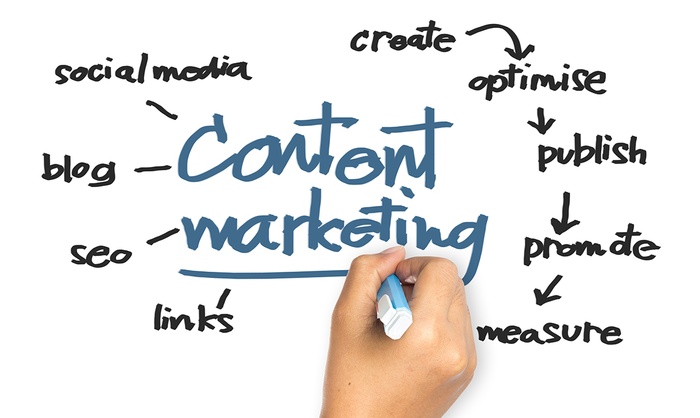As a business reporter on the front end of my career, I wrote daily articles and news briefs for the next day’s newspaper. Clearly, I was producing content, and most often, it was for a targeted audience interested in the happenings of the area’s business community. But content in those days reached only as far as the paper’s pass-along readership with no hope of going viral.
In today’s digital environment, content is a commodity, and the distribution of it a true marketing strategy. From social media and blog posts to whitepapers and videos, creating and sharing relevant content helps your brand educate and inform potential customers so that they can get to know, like and trust you enough to do business with you.
According to research from the Content Marketing Institute, 88 percent of B2B marketers use content marketing as a primary part of their marketing strategy. One big reason is that those who embrace content marketing as an important marketing tool record conversion rates that are six times higher than non-adopters, according to CMI research.
 Content marketing can work for virtually any business in any industry, as long as it’s relevant and consistent. Relevant content is useful information that addresses industry trends or issues, or applies the “local angle” to a trending industry topic or current event. The best content doesn’t try to sell, rather it educates, informs or entertains.
Content marketing can work for virtually any business in any industry, as long as it’s relevant and consistent. Relevant content is useful information that addresses industry trends or issues, or applies the “local angle” to a trending industry topic or current event. The best content doesn’t try to sell, rather it educates, informs or entertains.
For those considering content marketing as part of the marketing mix, here are three things to remember:
• Create content that people will want to read and share
If you have a company blog or social media platforms, your goal should be to consistently post compelling content designed to turn some of your readers or followers into customers. Consumers want information that informs, educates or entertains, so writing quality content that speaks to your target audience is the key to growing impressions and engagement. To us, quality content means offering a unique perspective on a topic our audiences care about or telling a success story. At Jackson, we have a blog series called “Fresh Catch,” which essentially consists of mini case studies on successful marketing projects we’ve completed. More than once, a potential client has contacted us about how we might approach their experiential marketing event or rebranding project after reading one of those posts.
What about content length? For new writers on our blog team, the first question typically is: “How long does it have to be?” People like their word counts, but I say tell the story and let the words number where they may. Despite everything we read these days about our short attention spans, research shows that longer content (1,000+ words) tends to rank higher than shorter content in Google’s mysterious ranking algorithm.
CMI research also shows that bulleted content receives more attention from search engines because they think the content has higher importance, which leads me to my second bullet.
• Optimize your content so people can find it in search engines
Every new blog post is another page on your website to be indexed by Google. While more pages don’t always mean more search traffic, having more indexed content increases your opportunities to rank during a search query. And if you target topics that your customers and potential customers frequently search for, your pages should appear for those searches.
In his article The 6 Steps To Perfectly Optimizing Any Content, Neil Patel writes that content optimization is less about SEO best practices and more about creating a holistic content experience that builds trust. For example, rather than writing content that includes a bunch of keywords related to your topic, try creating content that matches a user’s intent, or the goal someone has in mind when typing a query into Google.
Neil shares three types of user intent in online searches: Transactional—a person wants to buy something; Navigational—a person seeks a specific resource, page or site; and Informational—a person wants additional information on a topic or answers to their questions. You typically can gauge intent by looking at keywords used in online queries, enabling you to serve up content that better addresses what your users want to read.
• Promote your content through multiple distribution channels
Like print, digital content has a shelf life, but well-written articles can live a long time on the web. Social media content receives its highest engagement within hours of publication then tapers off, but blog and video content can stay relevant for months.
From social media sharing to targeted email, there are several ways to distribute your content. According to research by Campaign Monitor, email offers the broadest reach while remaining cost-effective. For every $1 spent, email gives back $38 in ROI, according to the study.
Sharing your content on your social media platforms is another way to increase content exposure. And social platforms afford the opportunity for followers to share your content for broader reach and impressions.
At Jackson, for example, content first is posted to the blog on our website. From there, it is shared across our social platforms and shared by many of our associates across their social platforms. It then is reformatted into an e-blast that is distributed to a targeted list of clients and potential clients.
Jason DeMers of AudienceBloom cautions that content marketing shouldn’t be considered a fad or a buzzword, rather a necessity in today’s digital marketing world. If you need more convincing, read Jason’s The Top 10 Benefits of Content Marketing.








